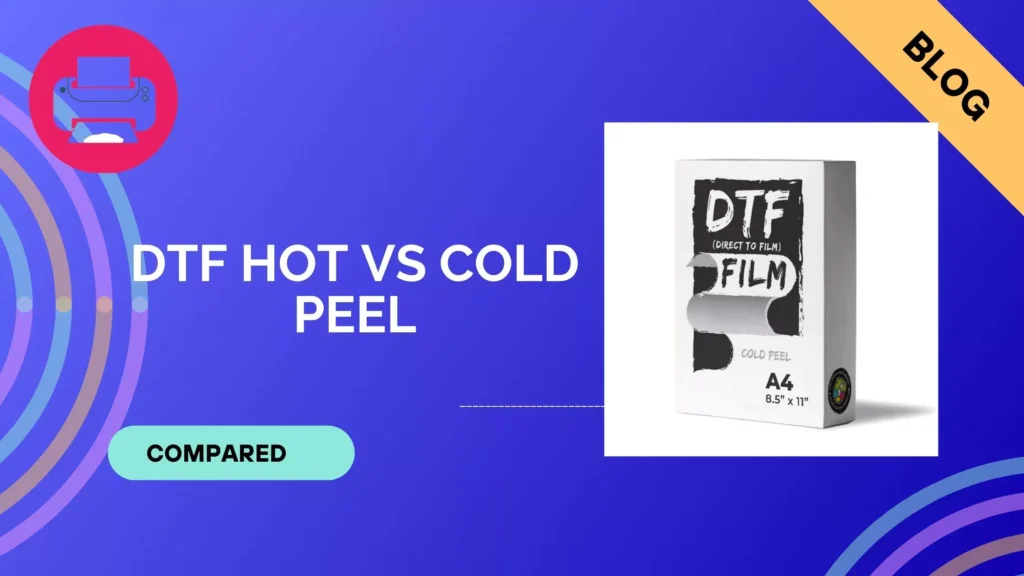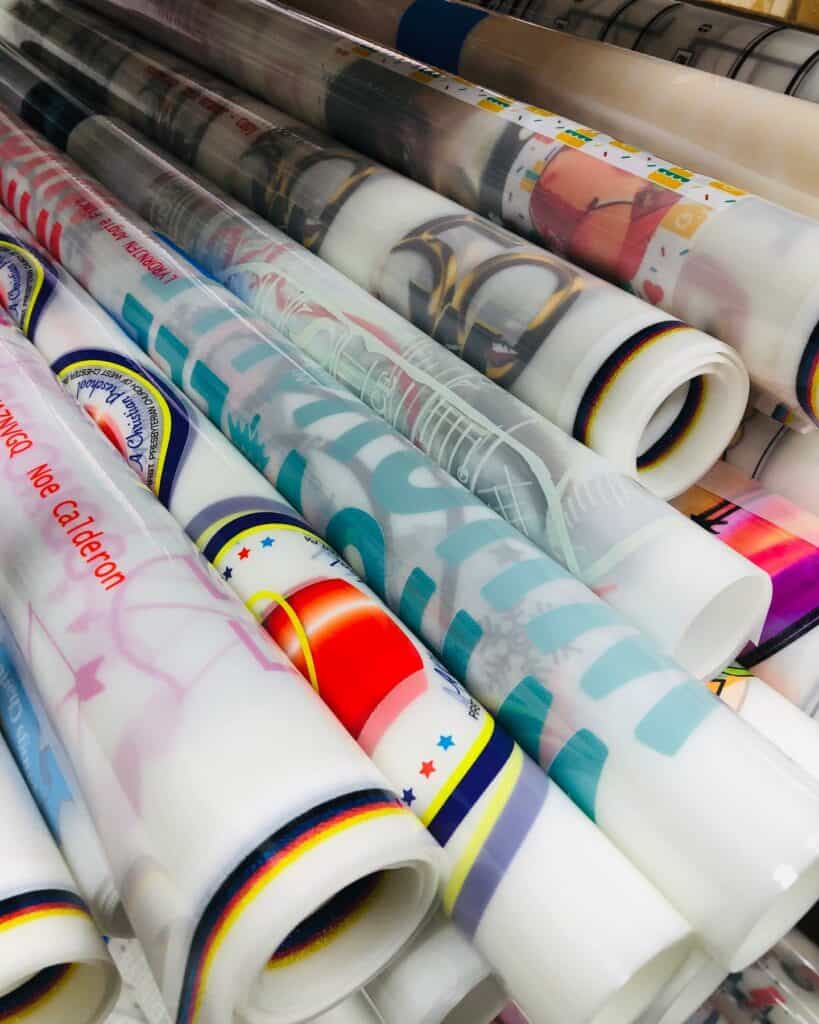Take your prints to the next level with the heated discussion of hot vs. cold peel in the world of DTF printing. Explore the amazing potential of each peel method as we delve into a world of dynamic options. Feel the heat of innovation with hot peel or embrace the cool precision of cold peel – your masterpiece, your rules. As we reveal the techniques to improve your DTF printing experience, let the reel of possibilities spin!

What is DTF Film?
DTF (Direct-To-Film) Film is a printing technique where designs are directly transferred from a digital format onto a special film, serving as a carrier for the t-shirt printing process. DTF makes it possible to print in brilliant, rich detail on a variety of surfaces, unlike older processes.
The terms “Hot Peel” and “Cold Peel” describe the various techniques for removing the film after printing, each having an impact on the outcome. In a hot peel, the film is peeled off while still heated, but in a cold peel, it is allowed to cool. Both methods enhance the quality and adaptability of DTF printing.
| Image | Product | Features | Price |
|---|---|---|---|
EDITOR’S CHOICE  | CenDale DTF Transfer Film – A4(8.3″ x 11.7″) 30 Sheets
| 9.9 | Check on AmazonGet A3 Size 30 Pcs |
BEST ALTERNATIVE  | Yamation DTF Transfer Film Glossy: 50 Sheets
| 9.8 | Check on Amazon |
HIGHLY VALUED  | Welacer DTF Transfer Film Paper – A4(8.4″ x 11.7″) 25 Sheets
| 9.6 | Check on AmazonGet A3+ Size 100 Pcs |
11×17″ SIZE  | CenDale 11″x17″ DTF Film –30 Sheets
| 9.9 | Check on AmazonGet 11″x17″ Size 60 Pcs |
PREMIUM 13×19″ SIZE  | Welacer Premium 13″x19″ DTF Film A3+ 100 Sheets
| 9.6 | Check on Amazon |
PREMIUM 13×19″ A3+ SIZE  | CenDale Premium DTF Film 13″x19″ – A3+ 50 Sheets
| 9.9 | Check on AmazonGet 13″x19″ 120 Pcs |
ON BUDGET  | KASYU DTF Transfer Film, 50 Sheets 8.5″*11″
| 9.5 | Check on AmazonGet A3 Size 50 Sheets |
11×17″ SIZE  | NGOODIEZ A3 DTF Film 11.7″ x 16.5″, 25 Sheets
| 9.5 | Check on Amazon |
AMAZON’S CHOICE  | JOYCUT A3 DTF Films for Inkjet Printers (11.7″×16.5″), 100 Sheets
| 8.2 | Check on AmazonGet A4 Size 30 Sheets |
Detail Differences Between Hot Peel Film and Cold Peel Film
When it comes to DTF (Direct-To-Film) printing, there are two different methods that you should know about that will affect how your prints turn out: Hot Peel Film and Cold Peel Film. Here are the subtle differences:
Hot Peel Film:
- Instant Removal: When using Hot Peel, the film is peeled off while it’s still warm right after the printing process.
- Soft Feel: This method generally improves the overall texture of the printed material by giving it a softer feel.
- Fast Production: Quick production turnaround times are facilitated by the quick peel process.
Cold Peel Film:
- Delayed Removal: In Cold Peel, the film is peeled off after it has cooled down after printing, therefore patience is essential.
- Crisper Details: Cold Peel is recommended in complex patterns to get crisper details.
- Delay in Peeling: Delays the peeling process, which makes it easier to handle details, particularly with tiny text and fine lines.
Selecting between Hot Peel and Cold Peel offers a customized way to improve your DTF printing experience, depending on your unique design needs and desired outcomes.
Different Pressing Temperature and Processing Time
The exact temperature and processing time during the pressing step of DTF printing determine the difference between Hot Peel Film and Cold Peel Film.
Hot Peel Film:
- Pressing Conditions: It requires 140 to 150°C as the pressing temperature.
- Duration: The five to ten seconds of pushing are comparatively short.
- Cooling: Before removing the film, it is enough to let it cool for two to three seconds after pressing.

Cold Peel Film:
- Pressing Conditions: A temperature of around 150–170°C is needed for this.
- Duration: The pressing process takes between 10 and 20 seconds, which is rather longer.
- Cooling: Unlike Hot Peel, Cold Peel demands a more extended cooling period of around 30 seconds post-pressing before the film can be torn off.
These particular temperature and time settings affect the result, satisfying your individual needs for overall print quality, texture, and detail. Depending on the specifications needed for a certain DTF printing job, either Hot Peel or Cold Peel should be used.
Application Materials, Transfer Features
The compatibility of Hot Peel Film and Cold Peel Film with various materials as well as their transfer properties are important considerations when it comes to DTF printing.
Hot Peel Film:
- Material Suitability: Both films are suitable for a range of textiles. However, caution is needed when dealing with specific materials like tarpaulin, coated cloth, canvas, and flannelette.
- Potential Difficulties: Because of the rapid peeling process, applying Hot Peel Film to some fabrics may cause problems including creases and even damage. When compared to Cold Peel Film, this could result to a worse print quality.
Cold Peel Film:
- Material Suitability: It works with a variety of textiles, much as Hot Peel Film.
- Special Fabrics: Cold Peel Film shines when dealing with special fabrics like tarpaulin and coated cloth, as well as rough textures such as canvas and flannelette.
- Benefits: Cold Peel Film’s delayed peeling gives these fabrics enough time to regain adhesion and flatness after heat pressing, preventing problems like creases. For producing high-quality prints with complicated patterns, tiny letters, icons, fine lines, and texture transfer, Cold Peel Film is especially suitable.
Basically, Cold Peel Film is the best option for tasks requiring exceptional accuracy and quality, particularly when working with difficult materials or complex design components.
Cost, Efficiency, Washing Fastness & Overall Suitability

Let’s examine how Hot Peel Film and Cold Peel Film vary in terms of price, effectiveness, washing fastness, and general applicability for various printing situations.
- Cost: The more complicated manufacturing process and exacting standards for coating precision and consistency in the coating machine make Hot Peel Film more expensive.
- Efficiency: Hot Peel Film is more efficient than other films since it can be quickly peeled off right after pressing, enabling quick output. Because of this, it is a good option in situations where speed is important since it can produce a large number of pieces quickly. Although Cold Peel Film provides excellent detail and granularity printing, its efficiency is comparatively inferior due to the longer peeling process.
- Washing Fastness: The adhesive layer of Hot Peel Film is created by a water-based back-coating process. The cooled glue can stick to the clothes if the film is not removed right away after pressing, making it difficult to remove the film and perhaps compromising its long-term washing fastness. Conversely, Cold Peel Film ensures high washing fastness by using an oil-based back-coating technique.
Which Is Better?
Selecting Hot Peel Film or Cold Peel Film depends on printing needs:
With its rapid turnaround times, Hot Peel Film is perfect for printing in big quantities on popular materials like cotton T-shirts.
When printing intricate and beautifully detailed designs on unique materials like tarpaulin, coated fabric, canvas, and flannelette, Cold Peel Film excels.
Your printing demands will determine the best DTF film for your company, taking into account ink-absorption capacity, coating layer, powder shaking effect, release effect, storage capacity, and high-temperature resistance.
Comparison Summary
| Criteria | Hot Peel Film | Cold Peel Film |
|---|---|---|
| Cost | Higher cost due to complex production process. | Lower cost due to less intricate manufacturing. |
| Efficiency | High efficiency, quick tear-off after pressing. | Lower efficiency, longer time for peeling. |
| Washing Fastness | Water-based adhesive; potential for sticking. | Oil-based adhesive; good washing fastness. |
| Suitability | Ideal for large volume printing on common fabrics. | Preferred for intricate patterns on special materials. |
| Printing Speed | Swift production, suitable for high-volume printing. | Slower process, especially for detailed prints. |
| Application Materials | Suitable for common fabrics like cotton. | Excellent for special fabrics and rough textures. |
| Quality | Good quality prints; suitable for standard applications. | Superior quality on details, ideal for intricate designs. |
| Considerations for Choice | Cost-effectiveness, speed of production. | Detail precision, quality of intricate prints. |
Conclusion
In conclusion, the specifics of your project will determine whether you should use Hot Peel Film or Cold Peel Film for DTF printing. While Cold Peel works best for complex patterns on unique materials, Hot Peel is best for large-scale, fast projects on standard textiles.
Think about what matters most to you: quick turnaround times and low costs, or fine detail and high quality. You get to make the decision based on the particular requirements of your printing business.
FAQs
The cost variation is influenced by the complexity of production processes, with Hot Peel Film requiring a more intricate manufacturing setup.
Yes, Cold Peel Film is versatile and suitable for various fabrics, offering excellent results even on common materials like cotton.
While peeling time is a crucial efficiency aspect, other factors like production speed and suitability for specific designs also contribute to the overall efficiency of each film type.
Hot Peel Film’s water-based adhesive layer may pose challenges if not promptly removed, potentially affecting long-term washing fastness.
Cold Peel Film is the preferred choice for intricate designs on special materials like tarpaulin, coated cloth, canvas, and flannelette.
Yes, key considerations include cost-effectiveness, speed of production for Hot Peel, and detail precision, along with superior quality for Cold Peel.
Hot Peel Film is ideal for common fabrics, while Cold Peel Film excels in printing on special fabrics and rough textures.
While both offer good quality, Hot Peel is suited for standard applications, whereas Cold Peel provides superior quality on intricate details and designs.
Cold Peel Film’s slower peeling process makes it less suitable for rapid, high-volume printing, especially when speed is a primary consideration.

Ashley Wang is a skilled sales manager with knowledge in DTF printing. She presently works for ShenLan Digital, a reputable DTF printer maker. Ashley is the best person to offer advice on selecting the most suitable DTF printer because she has tested a lot of them. She launched DTFPrinterSchool to educate individuals and organizations about DTF printing technology, providing her expertise and observations on the most recent advancements in the sector. Ashley is an invaluable resource for businesses and individuals wishing to invest in DTF printing technology because of her expertise and experience in the industry.
